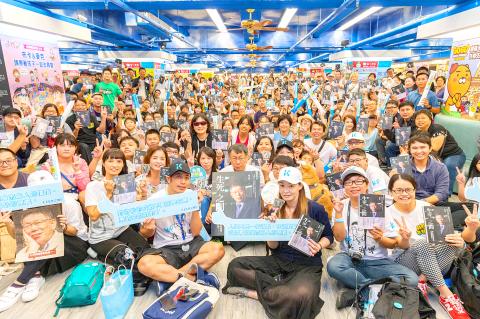The Taiwan People’s Party (TPP) added its second batch of 10 legislative candidates to its platform, it said yesterday, while Taipei Mayor Ko Wen-je (柯文哲), who is the party’s chairman, said the TPP’s goal is to prevent any single party winning more than half the legislative seats in the presidential and legislative elections on Jan. 11.
The candidates, all under the age of 45, identify with “pushing the pan-blue and pan-green camps to the side to allow for the people to be in the center,” the party said.
Ko at a campaign event in Kaohsiung said that ever since he left his former job as head of traumatology at National Taiwan University Hospital to enter politics in 2014, many voters have told him that they support him because he could achieve what others could not in breaking the pan-green, pan-blue divide.

Photo: Wang Chun-chung, Taipei Times
By nominating TPP legislators, he said he wants to prove that they can gradually realize what others thought was impossible.
The TPP wants to change Taiwan’s political culture, he said, adding that its participation in the legislative election is a social movement toward achieving that goal.
Ko said the party would also nominate 34 people for legislator-at-large seats, and their goal is for no party to win more than half of the legislative seats, so that minor parties could play a significant role in leading Taiwan to break away from the long-term battles between the pan-blue and the pan-green camps.
The 10 legislative candidates announced by the TPP include: Yen Yao-hsing (顏耀星), a former National Assembly representative, who would run in Tainan’s first constituency; former Chinese Nationalist Party (KMT) Kaohsiung delegate Ao Po-sheng (敖博勝), who would run in Kaohsiung’s eighth constituency; Chang Yue-jiang (張渝江), deputy chairman of Taichung Civil Engineers Association, who would run in Taichung’s fourth constituency; and Lee Min-wei (李旻蔚), daughter of Democratic Progressive Party New Taipei City Councilor Lee Hsu-tien (李余典), who would run in New Taipei City’s third constituency.

Taiwan is to commence mass production of the Tien Kung (天弓, “Sky Bow”) III, IV and V missiles by the second quarter of this year if the legislature approves the government’s NT$1.25 trillion (US$39.78 billion) special defense budget, an official said yesterday. Commenting on condition of anonymity, a defense official with knowledge of the matter said that the advanced systems are expected to provide crucial capabilities against ballistic and cruise missiles for the proposed “T-Dome,” an advanced, multi-layered air defense network. The Tien Kung III is an air defense missile with a maximum interception altitude of 35km. The Tien Kung IV and V

The disruption of 941 flights in and out of Taiwan due to China’s large-scale military exercises was no accident, but rather the result of a “quasi-blockade” used to simulate creating the air and sea routes needed for an amphibious landing, a military expert said. The disruptions occurred on Tuesday and lasted about 10 hours as China conducted live-fire drills in the Taiwan Strait. The Civil Aviation Administration (CAA) said the exercises affected 857 international flights and 84 domestic flights, affecting more than 100,000 travelers. Su Tzu-yun (蘇紫雲), a research fellow at the government-sponsored Institute for National Defense and Security Research, said the air

Taiwan lacks effective and cost-efficient armaments to intercept rockets, making the planned “T-Dome” interception system necessary, two experts said on Tuesday. The concerns were raised after China’s military fired two waves of rockets during live-fire drills around Taiwan on Tuesday, part of two-day exercises code-named “Justice Mission 2025.” The first wave involved 17 rockets launched at 9am from Pingtan in China’s Fujian Province, according to Lieutenant General Hsieh Jih-sheng (謝日升) of the Office of the Deputy Chief of the General Staff for Intelligence at the Ministry of National Defense. Those rockets landed 70 nautical miles (129.6km) northeast of Keelung without flying over Taiwan,

A strong continental cold air mass is to bring pollutants to Taiwan from tomorrow, the Ministry of Environment said today, as it issued an “orange” air quality alert for most of the country. All of Taiwan except for Hualien and Taitung counties is to be under an “orange” air quality alert tomorrow, indicating air quality that is unhealthy for sensitive groups. In China, areas from Shandong to Shanghai have been enveloped in haze since Saturday, the ministry said in a news release. Yesterday, hourly concentrations of PM2.5 in these areas ranged from 65 to 160 micrograms per cubic meter (mg/m³), and pollutants were